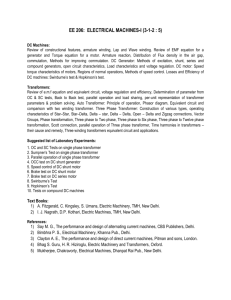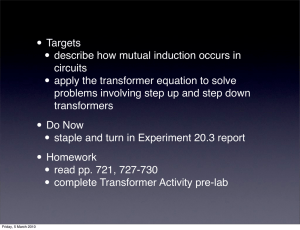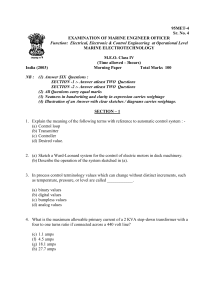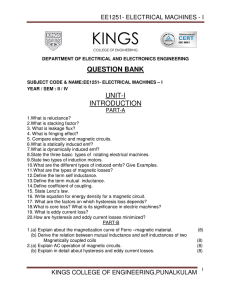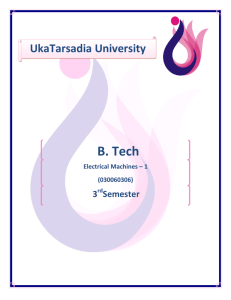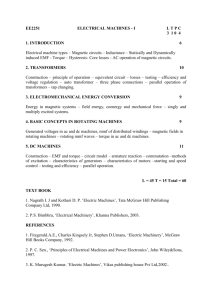KINGS UNIT-I QUESTION BANK
advertisement
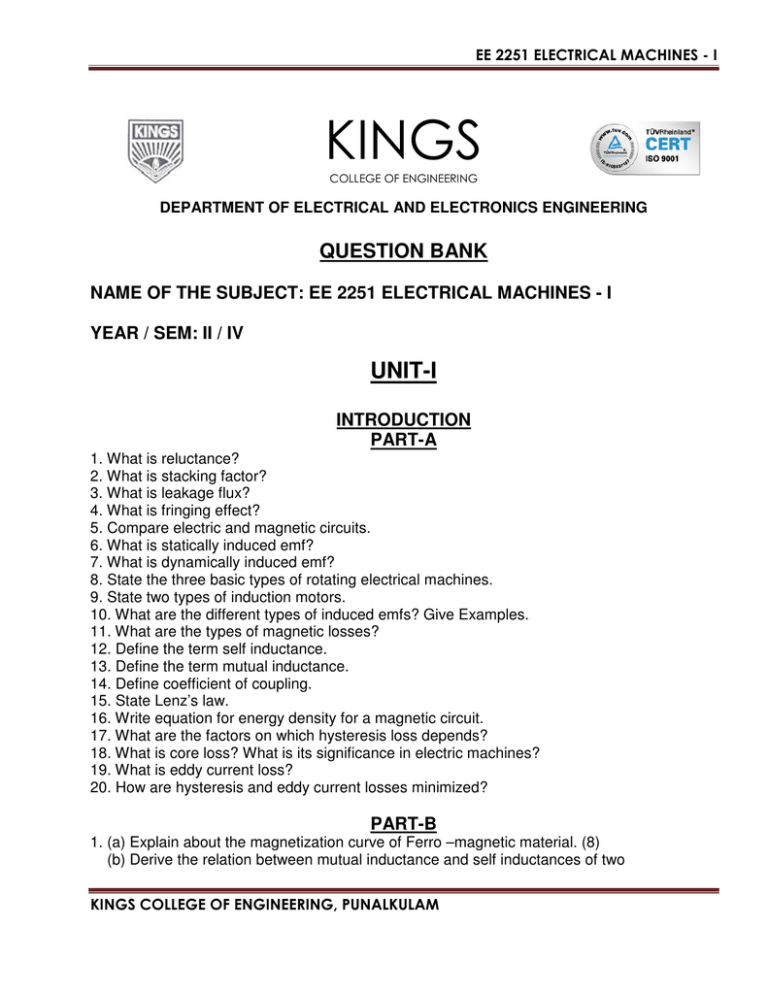
EE 2251 ELECTRICAL MACHINES - I KINGS COLLEGE OF ENGINEERING DEPARTMENT OF ELECTRICAL AND ELECTRONICS ENGINEERING QUESTION BANK NAME OF THE SUBJECT: EE 2251 ELECTRICAL MACHINES - I YEAR / SEM: II / IV UNIT-I INTRODUCTION PART-A 1. What is reluctance? 2. What is stacking factor? 3. What is leakage flux? 4. What is fringing effect? 5. Compare electric and magnetic circuits. 6. What is statically induced emf? 7. What is dynamically induced emf? 8. State the three basic types of rotating electrical machines. 9. State two types of induction motors. 10. What are the different types of induced emfs? Give Examples. 11. What are the types of magnetic losses? 12. Define the term self inductance. 13. Define the term mutual inductance. 14. Define coefficient of coupling. 15. State Lenz’s law. 16. Write equation for energy density for a magnetic circuit. 17. What are the factors on which hysteresis loss depends? 18. What is core loss? What is its significance in electric machines? 19. What is eddy current loss? 20. How are hysteresis and eddy current losses minimized? PART-B 1. (a) Explain about the magnetization curve of Ferro –magnetic material. (8) (b) Derive the relation between mutual inductance and self inductances of two KINGS COLLEGE OF ENGINEERING, PUNALKULAM EE 2251 ELECTRICAL MACHINES - I Magnetically coupled coils (8) 2. (a) Explain AC operation of magnetic circuits. (8) (b) Explain in detail about hysteresis and eddy current losses. (8) 3. (a) Write in detail about magnetically induced emf &force. and derive the relevant Expression. (8) (b) An electromagnetic relay has an exciting coil of 800 turns. The coil has a cross section of 5 cm x 5cm . Find 1. Coil inductance if the air gap length is 0.5 cm. 2. field energy stored for a coil current of 1.25 A 3. Permeance at air gap (8) 4. Explain in detail about three basic rotating electric machine types (16) 5. (a) Compare magnetic and electric circuit. (8) (b) An iron rod 1.8 cm diameter is bent to form a ring of mean diameter 25cm and wound with 250 turns of wire . a gap of 1mm exists in between the end faces. calculate the current required to produce a flux of 0.6mWb. take relative permeability of iron as 1200 (8) 6. (a) Explain the two different types of magnetic circuits with neat diagram. (8) (b) When two coils are connected in series, their effective inductance is found to be 10H .When the connections of one coil are reversed , the effective inductance is 6H.If the coefficient of coupling is 0.6, calculate the self inductance of each coil and the mutual inductance. (8) UNIT-II TRANSFORMERS PART-A 1. Mention the difference between core and shell type transformers. 2. What is the purpose of laminating the core in a transformer? 3. Give the emf equation of a transformer and define each term. 4. Does transformer draw any current when secondary is open? Why? 5. Define voltage regulation of a transformer. 6. Full load copper loss in a transformer is 1600W. what will be the loss at half load? 7. Define all day efficiency of a transformer. 8. Why transformers are rated in kVA? 9. What are the typical uses of auto transformer? 10. What are the application of step-up & step-down transformer? 11. How transformers are classified according to their construction? 12. Explain on the material used for core construction? 13. How does change in frequency affect the operation of a given Transformer? 14. What is the angle by which no-load current will lag the ideal applied voltage? 15. List the arrangement of stepped core arrangement in a transformer. 16. What is the function of transformer oil in a transformer? 17. Distinguish power transformers & distribution transformers. KINGS COLLEGE OF ENGINEERING, PUNALKULAM EE 2251 ELECTRICAL MACHINES - I 18. What are properties of an ideal transformer? 19. Give the condition to be satisfied for parallel operation of transformer. 20. What are different losses occurring in a transformer? PART-B 1. (a) Explain the principle and operation of auto transformer. (8) (b) Draw and explain the no load phasor diagram of a single phase transformer (8) 2. (a) Derive the emf equation of single phase transformer. (8) (b) A 120kVA, 6000/400V, Y/Y, 3-phase, 50Hz transformer has a iron loss of 1800W. The maximum efficiency occurs at ¾ full loads. Find the efficiency of the transformer at (i) Full load and 0.8 pf (ii) The maximum efficiency at unity pf. (8) 3. A100 kVA, 6.6kV/415V, single phase transformer has an effective impedance of (3+8j) _ referred to HV side. Estimate the full load voltage regulation at 0.8 pf lagging and 0.8 leading pf. (16) 4. (a) Explain the working of auto transformer and prove that when transformation ratio approaches unity, the amount copper used approaches smaller value. (8) (b) The emf per turn of a single phase, 6.6kV/440V, 50 Hz transformer is approximately 12V. Calculate the number of turns in the HV and LV windings and the net cross sectional area of the core for a maximum flux density of 1.5T. (8) 5. (a) Obtain the equivalent circuit of a 200/400V,50Hz,single phase transformer from the following test data: OC test: 200V,0.7A,70W on LV side SC test: 15V,10A,85W on HV side (10) (b) With the help of circuit diagrams, explain any two types of three phase transformer connections (6) 6. Find the all day efficiency of a 500kVA, distribution transformer whose iron loss and full load copper loss are 1.5kW and 6kW respectively. In a day it is loaded as follows: Duration(Hi) Output(Po) in kW Power factor(cosØ2) 6 400 0.8 10 300 0.75 4 100 0.8 4 0 - (16) 7. Draw the circuit diagrams for conducting OC and SC tests on a single phase transformer. Also explain how the efficiency and voltage regulation can be estimated by these tests. (16) 8. What is the sumpner’s test? Draw the circuit diagram to conduct this test and explain its principle. (16) 9. (a) Derive the condition for maximum efficiency in a transformer (8) (b) A11000/230 V,150 KVA ,1-phase ,50 Hz transformer has core loss of 1.4Kw and F.L cu loss of 1.6 Kw .determine (i) The kVA load for maximum efficiency and the value of maximum efficiency at unity p.f (ii) The efficiency at half F.L 0.8 pf leading (8) 10. Explain in detail about parallel operation of single phase transformers. (16) KINGS COLLEGE OF ENGINEERING, PUNALKULAM EE 2251 ELECTRICAL MACHINES - I 11. Data of a 500KVA, 3300/400 V ,50 Hz ,single phase transformer is given below. S.C test: 1250 W,100 V –secondary short circuited with full load current in it O.C test : 1000 W –with normal primary voltage . Calculate the full load regulation and efficiency at a power factor of 0.8(lag) (16) 12. (a) Derive the equivalent circuit of a single phase two winding transformer. (8) (b) The maximum efficiency of a single phase 250kVA,2000/250 V transformer occurs at 80% of full load and is equal to 97.5% at 0.8 pf .determine the efficiency and regulation on full load at 0.8pf lagging if the impedance of the transformer is 9 percent (8) 13. Explain in detail about tap changing of transformers. (16) UNIT-III ELECTROMECHANICAL ENERGY CONVERSION PART-A 1. Write the energy balance equation of a motor. 2. What is the energy conversion medium in a singly-excited magnetic field system? 3. What is the basic feature of an electro magnetic energy conversion devices? 4. Why does the energy storage in a magnetic material occurs mainly in the air gap? 5. What is multiply excited magnetic field system? 6. Give the relation between energy and co-energy for linear system. 7. Give an examples for each of single and multiple excited system 8. Write the applications of singly and doubly fed magnetic systems. 9. Why the field in rotating machines should be quasi-static in nature? 10. What are the causes for irrecoverable energy loss when the flux in the magnetic circuit undergoes a cycle 11. Why the relationship between current & coil flux linkages of electromechanical energy conversion devices are linear 12. With respect to the magnetic field ,in which direction does the force act? PART-B 1. Explain in detail about energy in magnetic system (16) 2. (a) With one example derive the co-energy of a multi excited magnetic field system (8) (b) two coupled coils have self and mutual inductance of L11 = 3+0.5 x ;L22 = 2+0.5x ; L12= L21=0.3x Over a certain range of linear displacement x. The first coil is excited by a constant current of 15A and the second by a constant current of -8A. (i) Mechanical work done if x changes from 0.6 to1m (ii)Energy supplied by each electrical source in part 1 (8) 3. (a) With neat sketch explain the multiple excited magnetic field system in electro mechanical energy conversion systems. Also obtain the expression for field energy in KINGS COLLEGE OF ENGINEERING, PUNALKULAM EE 2251 ELECTRICAL MACHINES - I the system. (8) (b) Draw and explain the general block diagram of an electromechanical energy conversion device (8) 4. Two coupled coils have self and mutual inductance of L11=2+1/(2x); L22=1+1/(2x): L12= L21=1/(2x). Over a certain range of linear displacement x. The first coil is excited by a constant current of 20A and the second by a constant current of -10A. (i) Mechanical work done if x changes from 0.5to1m (ii) Energy supplied by each electrical source in part 1 (iii) Change in field energy in part1 Hence verify that the energy supplied by the sources is equal to the increase in field energy plus the mechanical work done (16) 5. Explain the i-_ characteristics of a magnetic system .also derive expression for co energy density assume the i-_ relationship of the magnetic circuit is linear (16) 6. Consider an attracted armature relay is exited by an electric source.Explain about the mechanical force developed and the mechanical energy output with necessary equations. For linear and non linear cases. (16) UNIT-IV BASIC CONCEPTS OF ROTATING MACHINES PART-A 1. Explain the following terms with respect to rotating electrical machines 2. State advantages of short- pitched coils. 3. Define rotating magnetic field 4. Define pitch factor. 5. Give the equation for emf generated in D.C.machine. 6. Define winding factor. 7. What are distributed windings? 8. How is voltage generated in rotating machines? 9. Write the torque equation for round rotor machine. 10. Which type of winding is suitable for ac machines? PART-B 1. (a) Derive an expression for the generated emf in synchronous machines. (8) (b) A 50 Hz synchronous salient pole generator is driven at 125 rpm .there are 576 stator slots with two conductors per slot .air gap diameter is 6.1 m and stator length is 1.2m . sinusoidal flux density has a peak of 1.14T.Calculate the line voltage induced for star connection. (8) 2. Derive the torque equation of a round rotor machine. Also clearly state what are the assumptions made? (16) 3. Write in detail about the MMF space wave of three phase distributed winding. (16) 4. Explain in detail about construction of synchronous machine (16) 5. Write in detail about magnetic fields in rotating machines. (16) KINGS COLLEGE OF ENGINEERING, PUNALKULAM EE 2251 ELECTRICAL MACHINES - I 6. (a) Explain with neat diagram the concept of MMF space wave of single coil (8) (b) A 3-phase ,400 kVA ,50 Hz star connected alternator (synchronous generator) running at 300 rpm is designed to develop 3300 V between terminals .the armature consists of 180 slots ,each slot having one coil side with 8 conductors . Determine the peak value of the fundamental mmf in AT/pole when the machine is delivering full load current. (8) 7. (a) A 3-phase 50 kW ,4-pole ,50 Hz induction motor has a winding (ac) designed for delta connection . the winding has 24 conductors per slot arranged in 60 slots.The rms value of the line current is 48A. find the fundamental of the mmf wave of phase –A when the current is passing through its maximum value . what is the speed and peak value of the resultant mmf/pole? (8) (b) Explain in detail about torque –production process of synchronous machine(motoring) (8) 8. (a) Explain in detail about torque -production process of synchronous machine(generating) (8) (b) A 50 Hz ,400v ,4-pole cylindrical synchronous generator has 36slots,two –layer winding with full pitch coils of 8 turns each. The mean air –gap diameter is 0.16m,axial length 0.12m and a uniform air gap of 2mm. calculate the value of the resultant AT/pole and the peak air gap flux density . the machine is developing an electromagnetic torque of 60 Nm as a generator at a torque angle of 260 .what should be the rotor AT/pole? what is the stator AT and the angle it makes with the resultant AT? Also find the stator current. (8) UNIT-V DC MACHINES PART-A 1 Write down the emf equation for d.c.generator. 2. Why the armature core in d.c machines is constructed with laminated steel sheets instead of solid steel sheets? 3. Why commutator is employed in d.c.machines? 4. Distinguish between shunt and series field coil construction. 5. How does d.c. motor differ from d.c. generator in construction? 6. How will you change the direction of rotation of d.c.motor? 7. What is back emf in d.c. motor? 8. What is the function of no-voltage release coil in d.c. motor starter? 9. Enumerate the factors on which speed of a d.c.motor depends. 10. Under What circumstances does a dc shunt generator fails to generate? 11. Define critical field resistance of dc shunt generator. 12. Why starter is necessary for a dc motor? 13. What are the conditions to be fulfilled by for a dc shunt generator to build back emf? 14. Define armature reaction . 15. What are the different methods of speed control in dc motor? KINGS COLLEGE OF ENGINEERING, PUNALKULAM EE 2251 ELECTRICAL MACHINES - I 16. When you will say the motor is running at base speed? 17. List out the different methods of speed control employed for dc series motors 18. What are the losses occurring in a dc machine? 19. What are the drawbacks of brake test on DC machines?. 20. What is a regenerative test? PART-B 1. (a) Describe with sketches the construction of a DC machine. (8) (b) Derive the EMF equation of DC generator. (8) 2. Draw and explain the no-load and load characteristics of DC shunt, series and compound generators. (16) 3. Explain the effect of armature reaction in a DC shunt generator. How are its demagnetizing and cross-magnetizing ampere turns calculated? (16) 4. Explain the process of commutation in a DC machine. (16) 5. With a aid of a circuit diagram, describe the procedure for paralleling two DC shunt generators and for transferring the load from one machine to the other. (16) 6. A 4-pole, 50 kW, 250 V, wave wound shunt generator has 400 armature conductors. Brushes are given a lead of 4 commutator segments. Calculate the demagnetization ampere-turns per pole if shunt field resistance is 50 ohm. Also calculate extra shunt field turns per pole to neutralize the demagnetization. (16) 7. A 4-pole, lap connected DC machine has 540 armature conductors. If the flux per pole is .03 Wb and runs at 1500 RPM, determine the emf generated. If this machine is driven as a shunt generator with same field flux and speed, calculate the line current if the terminal voltage is 400V.Given the RSH=450_ and RA=2 _. (16) 8. Two separately excited DC generators are connected in parallel and supply a load of 200A. The machines have armature circuit resistances of 0.05 _ and 0.1 _ and induced emfs of 425V and 440V respectively. Determine the terminal voltage, current and power output of each machine. The effect of armature reaction is to be neglected. (16) 9. (a) Explain the principle of operation of a DC motor. (8) (b) A shunt machine , connected to a 200V mains has an armature resistance of 0.15 _ and field resistance is 100 _. Find the ratio of its speed as a generator to its speed as a motor, line current in each case being 75 A. (8) 10 (a) Draw and explain the mechanical characteristics of DC series and shunt motor.(8) (b) A 230V, DC shunt motor, takes an armature current at 3.33A at rated voltage and at a no load speed of 1000RPM. The resistances of the armature circuit and field circuit are 0.3 _ and 160 _ respectively. The line current at full load and rated voltage is 40A. Calculate, at full load, the speed and the developed torque in case the armature reaction weakens the no load flux by 4%. (8) 11. (a) Describe the working of 3 point starter for DC shunt motor with neat diagram. (8) (b) Explain Ward-Leonard method of speed control in DC motors. (8) 12. (a) Derive an expression for the torque developed in a DC machine. (8) (b) A 220V, Dc shunt motor with an armature resistance of 0.4 _ and a field resistance of 110 _ drives a load , the torque of which remains constant. The motor draws KINGS COLLEGE OF ENGINEERING, PUNALKULAM EE 2251 ELECTRICAL MACHINES - I from the supply, a line current of 32A when the speed is 450 RPM. If the speed is to be raised to 700RPM, what change must be effected in the value of the shunt field circuit resistance? Assume that the magnetization characteristics of the motor is a straight line. (8) 13. Explain the different methods used for the speed control of D.C. shunt motor. (16) 14. With the help of neat circuit diagram, explain swinburne’s test and derive the relations for efficiency (both for generator and motor)also state the merits and demerits of this method (16) 15. (a) Explain in detail about circuit model of D.C. machine. (8) (b) A 440 V D.C shunt motor takes 4A at no load . its armature and field resistances are 0.4 ohms and 220 ohms respectively .estimate the kW output and efficiency when the motor takes 60A on full load. (8) 16. (a) Derive an expression for the torque developed in the armature of a D.C. motor.(8) (b) Determine developed torque and shaft torque of 220V, 4 pole series motor with 800 conductors wave-connected supplying a load of 8.2 kW by taking 45A from the mains. The flux per pole is 25m/Wb and its armature circuit resistance is 0.6_. (8) 17. With the help of neat circuit diagram, explain Hopkinson’s test and derive the relations for efficiency (both for generator and motor)also state the merits and demerits of this method. (16) 18. (a) Explain in detail about different methods of excitation. (8) (b) Derive the expression for efficiency of D.C. machines. (8) *********** X *********** ALL THE BEST KINGS COLLEGE OF ENGINEERING, PUNALKULAM
